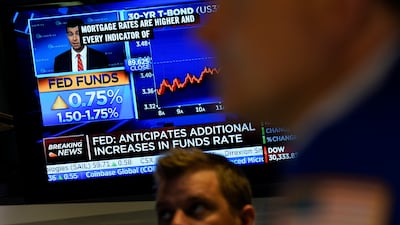On Wall Street, stocks are officially in a bear market and there has been a sell-off in US government bonds as monetary policymakers attempt to get a grip on rampant inflation. Bitcoin is around its December 2020 lows after a crash for cryptocurrencies.
Concerns are around the outlook for economic growth and how rising interest rates could impact the outlook. Investor sentiment has been on the downturn all year amid the war in Ukraine, sanctions on Russia, oil prices above $120 per barrel, and a resurgence of Covid-19 in China that has further disrupted supply chains. Inflation is at multi-decade highs and Goldman Sachs suggests a recession is on the way in the US.
The point of the spear was forged in the wake of the pandemic and the sharp economic rebound that followed. It provided a fresh shock for trade networks and markets that had experienced a sudden stop across many sectors in 2020. Job cuts are not easy to reverse in a short period of time and many industries have been unable to keep up with the scale of the return of demand. Oil and gas supplies, for example, take time to build up. The result of the recovery in 2021 was a ramp up in costs for everyone. It was a very expensive rebound. But it was also a fragile one. Policymakers can be forgiven for prioritising the return of higher levels of economic activity over any concerns about inflation, which they hoped was only temporary. Now they accept that inflation could become endemic.
Central banks are moving with greater urgency to stem the overheating of economies. On Wednesday, the US Federal Reserve, for example, announced its biggest rate hike in almost 30 years.
Britain’s central bank raised rates on Thursday also. The European Central Bank says it will do so next month. Brazil has already been moving much faster than developed nations, while India has raised its key interest rate two months consecutively.
Although not every country has followed the pattern – Japan’s central bank has kept rates near record lows and Turkey has been pushing its own unorthodox strategy of tackling inflation with rate cuts. China has instead focused on offering monetary support amid an economic slowdown. The Fed, by and large, will lead the way for the world. In the GCC, most central banks follow US policy rate moves due to the peg of their currencies to the US dollar.
Fed Chair Jerome Powell attempted to calm anxiety over Wednesday’s historic move on rates while also raising expectations of another big rate increase in July.
“We’re not trying to induce a recession,” he said. “Let’s be clear about that.”
However, a cooling off is exactly what is needed right now to ease the cost-of-living crisis that is affecting food, fuel and numerous other products. It is affecting everyone in the world to varying degrees.
A forced slowing of growth now, soothing inflation expectations, would allow central bankers to avoid more rate hikes in future, with the aim of achieving the near mythical “soft landing”. It will be bumpy but perhaps not a hard crash. That would allow for a swing back toward more positive momentum with minimal expense in terms of time and money lost. It is a difficult balancing act and trust in policymakers is in short supply in general. Investors may have several tantrums as a result of the uncertainty around what happens next. They are feeling genuine pain, remember.
Less than half of Americans have faith that Mr Powell would succeed at reigning inflation in without damaging the economy too badly. In the UK, more people are dissatisfied than satisfied with the performance of the Bank of England. And Bank of Japan Governor Haruhiko Kuroda is deemed unfit for the job by a majority of people.
Amid such low levels of trust, will investors, consumers and executives be patient enough to let these policy moves play out? It is more likely we will see panic and volatility in the months ahead.
Of course, history is also against these central bankers being able to avoid recession. The question is then “How long would a downturn last?”
Fundamentals would back up the theory that the US economy at least would bounce back fairly quickly. The job market is booming with unemployment near a 50-year low. Household debt is not at the risky level it was at during the 2009 financial crisis. The banks are in a fairly strong position.
But as analysts say, the Fed is walking a tightrope with regards to steering the US economy through the remainder of the year.
“I think that what’s becoming more clear is that many factors that we don’t control are going to play a very significant role in deciding whether that’s possible or not," conceded Mr Powell.
The truth is, as risky as his route may be, we have little choice other than to see it through.


